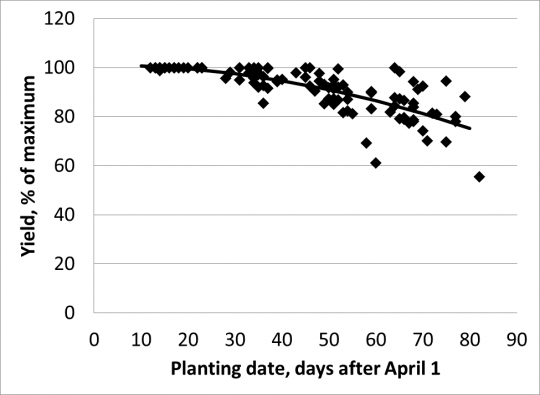ILSOYADVISOR POST
What does a cool, wet spring mean for soybean growers?
March 25, 2019
Early springs can create trying conditions for producers. In 2018, it snowed in Illinois on April 9. It was cool and wet through the middle of April, leading many growers to reconsider plans to attempt to plant beans before corn. The cool, wet conditions lasted until the end of the month, delaying the planting season in many areas. So far, 2019 seems to be following the same pattern, with cool saturated soils thus far. The National Weather Service predicts a moderate possibility of wetter and cooler than normal conditions through at least the end of the month. What does a cool wet spring mean for soybean growers?
Resist the temptation to plant into unfavorable soil conditions. Although there is much truth to the hype surrounding the yield advantages derived from planting soybeans much earlier than historical norms, it is critical that soil conditions are favorable before planting. Planting into wet soils can result in compaction, improper seed spacing and reduced stands. Soil crusting can also be a concern with excessive tillage before planting or heavy rain after. Very cool soil temperatures at planting decrease the speed at which seedlings emerge from the soil, increasing the risk associated with a heavy rainfall prior to emergence. There are clear yield advantages to planting soybeans earlier than May 1, but these are negated when soil conditions are less than ideal.
Consider planting beans while preparing corn fields. The soil conditions so far this year have delayed spring field work in most areas of the state of Illinois. If this pattern holds, field conditions will allow spring nitrogen application at roughly the same time as the fields are ready for planting. The waiting period between spring anhydrous application and corn planting would be a great window to test the benefits of early planted beans.
Protect seedlings against disease. Wet soil conditions favor the development of many seedling diseases, including Phytophthora, Pythium and Rhizoctonia. Fortunately for growers, there are some practices which can combat these diseases. Seed treatments are effective, however diverse fungal species respond differently to specific fungicides. No single fungicide is effective against all seedling diseases, so be sure to select a seed treatment that has multiple active ingredients for a broad range of effectiveness against multiple pathogens. Genetic resistance is also available for Phytophthora, so choose varieties with one or more resistance genes and good field tolerance for fields in which this disease can be a problem.


Example of Pythium in seedlings. (Photos courtesy of Stephanie Porter).
Be Patient. University of Illinois data indicate that maximum soybean yield is achieved by planting from mid-April to the end of the month. However, the yield potential decrease is gradual after May 1, losing about a quarter bushel per day, with a 7% loss by May 15. This is not insignificant but, as previously described, the risks of planting into unfavorable conditions are greater than the potential rewards. And if soil conditions prevent you from planting as early as you’d like, look at the bright side. Later planting dates decrease the risk of frost injury.

1 Combined results over 26 soybean planting date trials in central and northern Illinois, 2010 to 2016. (University of Illinois.)





Comments
Add new comment